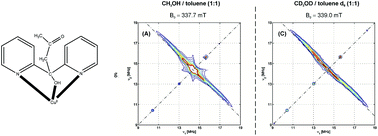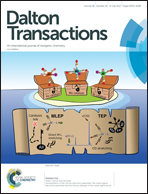Probing the electronic structure of a copper(ii) complex by CW- and pulse-EPR spectroscopy†
Abstract
Nucleophilic attack by the carbanion −:CH2COCH3 at the carbonyl group of di-2-pyridyl ketone, (py)2CO, in the presence of CuII under moderately basic conditions has yielded the cationic mononuclear complex [Cu{(py)2C(CH2COCH3)(OH)}2](NO3)2·2H2O (1·2H2O) in ∼40% yield, where (py)2C(CH2COCH3)(OH) is the ligand bis(2-pyridine-2-yl)butane-1-ol-3-one. The CuII atom of the cation sits on a crystallographically imposed inversion center. The neutral molecule is coordinated to the metal ion as a tridentate fac chelating ligand through the hydroxyl oxygen atom and two 2-pyridyl nitrogen atoms. The pyridyl nitrogens are strongly coordinated to the metal ion, while the hydroxyl oxygen atoms form weak bonds with CuII. The coordination geometry at the CuII center is elongated octahedral. Various interactions build the crystal structure of the complex and Hirshfeld surface analysis was applied to evaluate the magnitude of interactions between the different chemical species in the crystal of 1·2H2O. IR, Raman and UV/VIS data of the solid complex are discussed in terms of the coordination mode of (py)2C(CH2COCH3)(OH), the ionic nature of nitrates and the stereochemistry at copper(II). The complex was studied in a frozen solution (MeOH–toluene, 1 : 1 v/v) by CW-EPR spectroscopy and advanced EPR methods such as ENDOR and HYSCORE. The results show that the low symmetry of the cation is retained in solution, with the four nitrogen atoms arranged in a square planar configuration and the unpaired electron residing in an orbital pointing towards them. The bonding parameters in the first coordination sphere and the spin density distribution have been fully analyzed based on the ligand hyperfine coupling constants.


 Please wait while we load your content...
Please wait while we load your content...